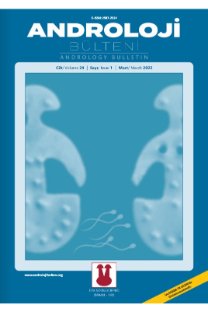İdiyopatik infertil hastalarda semen ve kan plazmasında malondialdehit, glutatyon peroksidaz, süperoksid dismutaz ve katalaz düzeyleri ile semen parametrelerinin ilişkisi
On the idiopathic infertile male patients, level of malondialdehyde, glutathion peroxidase, superoxide dismutase and catalase at sperm and blood plasma, and correlation between them
___
- 1. World Health Organization. WHO Manual for the Standardized Investigation, Diagnosis and Management of Infertile Male. Cambrige, UK: Cambrige University Press; 2000.
- 2. Thompson ST. Prevention of male infertility: an update. Urol Clin North Am. 1994;21:365–76. [CrossRef ]
- 3. Mosher WD, Pratt WF. Fecundity and Infertility in the United States: Incidens and Trends. Fertil Steril. 1991;56:192–3. [CrossRef ]
- 4. Hull MG, Glazener CM, Kelly NJ, Conway DI, Foster PA, Hinton RA, et al. Population study of causes treatment and outcome of infertility. Br Med J. 1985;291:1693–7. [CrossRef ]
- 5. Hull MG, Willams JA, Ray B, Mc Laughlin EA, Akande VA, Ford WC. The contribution of subtle oocyte or sperm dysfunction affecting fertilization in endometriosis-associated or unexplained infertility: a controlled comparison with tubal infertilitiy and use of donor spermatozoa. Hum Reprod. 1998;13:1825–30. [CrossRef ]
- 6. Fainberg J, Kashanian JA. Recent advances in understanding and managing male infertility. F1000Res. 2019;8(F1000 Faculty Rev):670. [CrossRef ]
- 7. Christova Y, James PS, Jones R. Lipid diffusion in sperm plasma membranes exposed to peroxidative injury from oxygen free radicals. Mol Reprod Dev. 2004;68:365–72. [CrossRef ]
- 8. El-Taieb MA, Ali MA, Nada EA. Oxidative stress and acrosomal morphology: A cause of infertility in patients with normal semen parameters. Mid East Fertil Soc J. 2015;2:79–85. [CrossRef ]
- 9. Alkan I, Şimşek F, Haklar G, Kervancioglu E, Ozveri H, Yalcin S, Akdas A. Reactive oxygen species productıon by the spermatozoa of patients with idiopathic infetility: realitionship to seminal plazma anti oxidants. J Urol. 1997;157:140–3. [CrossRef ]
- 10. Aydemir B, Onaran I, Kiziler AR, Alici B, Akyolcu MC. Increased oxidative damage of sperm and seminal plasma in men with idiopathic infertility is higher in patients with glutathione S-transferase Mu-1 null genotype. Asian J Androl. 2007;9:108–15. [CrossRef ]
- 11. Huang C, Cao X, Pang D, Li C, Luo Q, Zou Y, et al. Is male infertility associated with increased oxidative stress in seminal plasma? A-meta analysis. Oncotarget. 2018;9:24494–513. [CrossRef ]
- 12. Dutta S, Majzoub A, Agarwal A. Oxidative stress and sperm function: A systematic review on evaluation and management. Arab J Urol. 2019;17:87–97. [CrossRef ]
- 13. Agarwal A, Rana M, Qiu E, AlBunni H, Bui AD, Henkel R. Role of oxidative stress, infection and inflammation in male infertility. Andrologia. 2018;50:e13126. [CrossRef ]
- 14. Agarwal A, Saleh RA, Bedaiwy MA. Role of reactive oxygen species in the pathophysiology of human reprodiction. Fertil Steril. 2003;79:829–43. [CrossRef ]
- 15. Oehninger S. Pathophysiology of oligoastenospermia: Are we improwing in the diagnosis. Reprod biomed online. 2003;7:433– 9. [CrossRef ]
- 16. Kobayashi T, Miyazaki T, Natori M, Nozava S. Protective role of superxide dismutaze ın human sperm motilitiy: süperoxide dısmutaze activitiy and lipid peroxide in human seminal plasma and spermatozoa. Hum Repord. 1991;6:987–91. [CrossRef ]
- 17. Kurpisz M, Miesel R, Sanocka D, Jedrzejczak P. Seminal plasma can be a predictive factor for male infertilitiy. Hum Reprod. 1996;11:1223–6. [CrossRef ]
- 18. Zarghami N, Khosrowbeygi A. Levels of oxidative stres biomarkers in seminal plasma and their relationship with seminal praameters. BMC Clin Pathol. 2007;7:6. [CrossRef ]
- 19. Sanocka D, Miesel R, Jedrzejczak P, Kurpisz MK. Oxidative stress and male infertilitiy. J Androl. 1996;17:449–54. https:// onlinelibrary.wiley.com/doi/abs/10.1002/j.1939-4640.1996. tb01813.x?sid=nlm%3Apubmed
- 20. İyidoğan YÖ, Genç S, Koçak H, Akkuş E. Seminal plazma süperoksit dismutaz ve total antioksidan düzeylerinin erkek infertilitesine etkileri. Türk Üroloji Derg. 2003;29:296–300. https://www.acarindex.com/turk-uroloji-dergisiturkish-journal- of-urology/seminal-plazma-superoksid-dismutaz-ve-total- antioksidan-duzeylerinin-erkek-infertilitesine-etkileri-375981
- 21. Peltola V, Huhtaniemi I, Ahutupa M. Abdominal position of the rat testis in associated with high level of lipid peroxidation. Biol Reprod. 1995;3:1146–50. [CrossRef ]
- 22. Tesi EP, Ben-Azu B, Mega OO, Mordi J, Knowledge OO, Awele ED, et al. Kolaviron, a flavonoid-rich extract ameliorates busulfan-induced chemo-brain and testicular damage in male rats through inhibition of oxidative stress, inflammatory, and apoptotic pathways. J Food Biochem. 2022;e14071. [CrossRef ]
- ISSN: 2587-2524
- Yayın Aralığı: Yılda 4 Sayı
- Başlangıç: 1999
- Yayıncı: Turgay Arık
Kardiyak durumlar ve cerrahi girişim sonrası cinsellik
Cinsel sağlık dersi alan ve almayan öğrencilerin cinsel sağlık bakımına ilişkin inanç ve tutumları
Nurhan DOĞAN, Hatice YÜCELER KAÇMAZ, Gamze FIŞKIN
Ferroptoz ve erkek infertilitesi
Sezgin GÜNEŞ, Sercan ERGÜN, Gülgez Neslihan TAŞKURT HEKİM
Mevlüde ALPASLAN ARAR, Nülüfer ERBİL
Spermdeki odorant reseptörlerin rolü ve infertilite ile ilişkisi
Seda VATANSEVER, Gülsen Zübeyde KARAMAN
Malleabl penil protezin iki taraflı komplet fraktürü
Emir AKINCIOĞLU, Yusuf Özlem İLBEY, Orçun ÇELİK, Uygar MİÇOOĞULLARI, Furkan Umut KILIÇ
Peyronie hastalığının cerrahi tedavisinde kullanılan greft türleri
Ekrem AKDENİZ, Mahmut ULUBAY, Emrah KÜÇÜK, Mustafa Kemal ATİLLA
Hüseyin ÖZVEREN, Mustafa GÜNEŞ, İrfan Şafak BARLAS
Okul öncesi cinsel eğitime yönelik ebeveynlerin bilgi tutum ve uygulamaları
